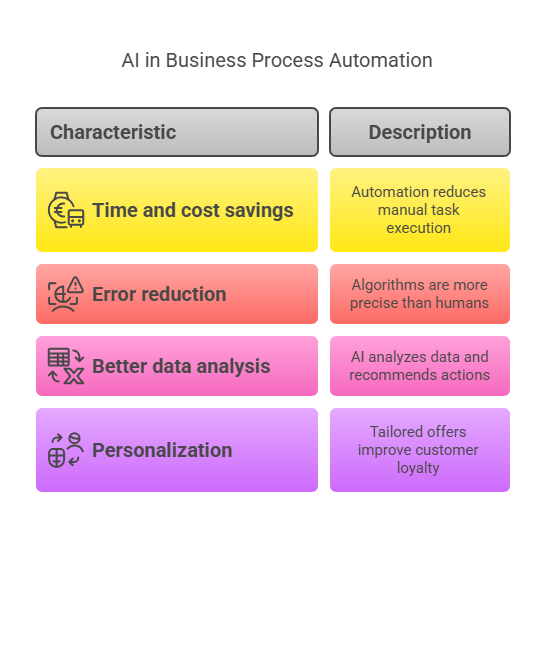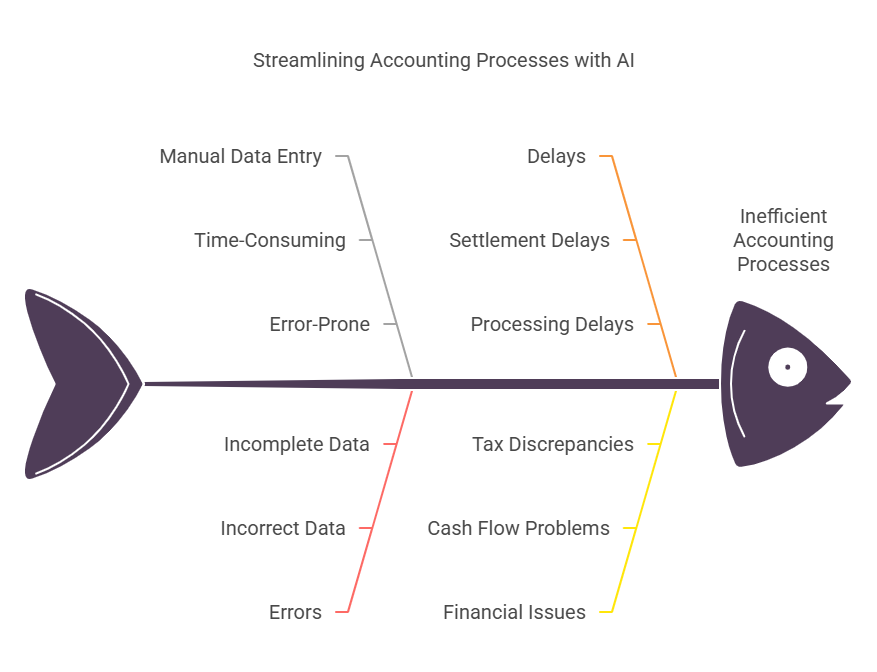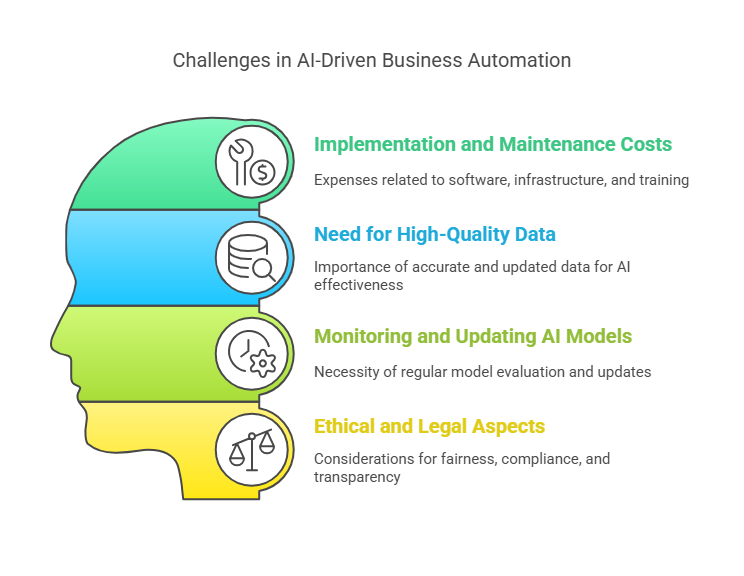Introduction to Business Process Automation with AI
What is Business Process Automation (BPA) with AI?
Business Process Automation (BPA) with artificial intelligence (AI) involves implementing solutions that allow computer systems to independently perform repetitive, time-consuming, or complex tasks. Thanks to AI, automation is no longer limited to simple rules and workflows—modern algorithms can analyze data, make decisions, learn from new information, and adapt to changing business conditions.
AI in business process automation enables, among other things, image and text recognition, sentiment analysis, demand forecasting, offer personalization, automated customer service, and anomaly detection. As a result, companies can increase efficiency, reduce costs, improve service quality, and respond more quickly to market needs.
Why Automate Business Processes with AI?
Implementing AI for business process automation brings a range of benefits that translate into a competitive advantage:
Time and cost savings – Automation eliminates the need for manual execution of repetitive tasks, allowing employees to focus on more creative and strategic activities.
Increased efficiency and scalability – AI systems can operate 24/7, handling thousands of operations simultaneously without a drop in quality.
Error reduction – AI algorithms are less prone to mistakes than humans, especially in tasks requiring precision and repetition.
Better data analysis – AI can analyze vast amounts of data in real time, draw conclusions, and recommend optimal actions.
Personalization and improved customer service – With AI, companies can tailor offers and communication to individual customer needs, increasing satisfaction and loyalty.
Key AI Technologies in Process Automation
Various AI technologies are used in business process automation, including:
Machine Learning – enables automatic pattern detection in data and decision-making based on those patterns.
Natural Language Processing (NLP) – allows for text analysis and generation, automated customer query handling, sentiment analysis, and information extraction from documents.
Image and audio recognition – AI can analyze photos, audio, and video recordings, which is useful in quality control, security, and marketing.
AI-powered Robotic Process Automation (RPA) – combines traditional automation with intelligent algorithms, enabling automatic processing of documents, invoices, or requests.
Recommendation systems – personalize offers, products, and content based on user behavior analysis.

Case Study 1: Customer Service Automation in E-commerce
Problem Description: High Service Costs, Long Response Times
In the e-commerce industry, one of the biggest challenges is providing fast and effective customer service. As the number of orders and inquiries grows, traditional support teams often struggle to keep up with customer questions, leading to long wait times, user frustration, and increased operational costs. Additionally, repetitive questions (such as order status, returns, product availability) take up a significant portion of consultants’ time—time that could be spent on more complex issues.
Solution: AI Chatbot for Handling Inquiries, Automated Sentiment Analysis
To address these problems, the e-commerce company implemented an AI-based solution:
AI Chatbot – A modern chatbot based on natural language processing (NLP) was deployed to automatically answer the most frequently asked customer questions via chat on the website or mobile app. The chatbot can recognize user intent, provide information about order status, product availability, return policies, and, if necessary, transfer the conversation to a human consultant.
Automated Sentiment Analysis – The AI system analyzes the tone and emotions in customer messages, allowing the company to quickly identify dissatisfied users and prioritize their cases. This enables faster responses to potential crises and improves service quality.
Sample code: Simple chatbot using the transformers library (Python)
from transformers import pipeline
# Create a conversational pipeline
chatbot = pipeline("conversational", model="facebook/blenderbot-400M-distill")
# Example conversation
from transformers import Conversation
conversation = Conversation("Where is my order?")
response = chatbot(conversation)
print(response)Results: Reduced Costs, Shorter Response Times, Increased Customer Satisfaction
Implementing AI for customer service brought tangible benefits to the e-commerce company:
Reduced operational costs – The chatbot handles most repetitive inquiries, allowing the company to reduce the number of consultants or reassign them to more valuable tasks.
Shorter response times – Customers receive answers instantly, regardless of the time of day or the number of inquiries.
Increased customer satisfaction – Fast and effective service leads to better reviews, greater loyalty, and a higher customer return rate.
Better crisis management – Automated sentiment analysis enables faster detection and resolution of issues before they turn into negative reviews.
Case Study 2: Automating Accounting Processes in a Manufacturing Company
Problem Description: Manual Data Entry, Errors, Delays
In manufacturing companies, accounting processes often involve a large number of documents, such as invoices, orders, or delivery confirmations. Traditional manual data entry into ERP systems is time-consuming, error-prone, and leads to delays in settlements. Incorrect or incomplete data can result in cash flow problems, tax discrepancies, and the need for costly corrections.
Solution: OCR System for Automatic Invoice Reading, AI for Transaction Classification
To streamline accounting processes, the company implemented AI-based solutions:
OCR System (Optical Character Recognition) – An AI-powered tool automatically recognizes and reads data from both paper and electronic invoices. The system can extract key information such as invoice number, dates, amounts, contractor data, and item lines.
AI for Transaction Classification – Machine learning algorithms analyze the extracted data and automatically assign transactions to the appropriate accounting categories, detect potential irregularities, and suggest appropriate actions (e.g., posting, flagging for review).

Sample code: Automatic text extraction from an invoice using Tesseract OCR (Python)
python
import pytesseract
from PIL import Image
# Load the invoice image
invoice_image = Image.open('invoice_sample.png')
# Read text from the image
text = pytesseract.image_to_string(invoice_image, lang='eng')
print(text)
Results: Error Reduction, Faster Processes, Time SavingsImplementing AI in accounting processes brought several benefits to the manufacturing company:
Error reduction – Automatic data reading and classification minimize the risk of mistakes associated with manual data entry.
Faster processes – Invoices are processed in real time, enabling quicker settlements and better financial control.
Time and cost savings – Employees can focus on analysis and process optimization instead of tedious data entry.
Better compliance and auditability – Automation makes it easier to meet legal and tax requirements and to prepare documentation for audits.
Case Study 3: Recruitment Automation in an HR Agency
Problem Description: Large Number of Applications, Difficulty in Candidate Selection
HR agencies and recruitment departments in large companies often have to process hundreds or even thousands of applications for a single position. Manual candidate selection is time-consuming, costly, and prone to subjectivity and human error. As a result, valuable candidates may be overlooked, and the recruitment process is prolonged, negatively affecting company efficiency and the candidate experience.
Solution: AI for Analyzing CVs and Cover Letters, Chatbot for Initial Interviews
To streamline the recruitment process, the HR agency implemented AI-based solutions:
AI for analyzing CVs and cover letters – Natural language processing (NLP) algorithms automatically analyze the content of application documents, identifying key competencies, work experience, technical and soft skills, and fit for the job requirements. The system can also detect inconsistencies or recurring patterns in applications.
Recruitment chatbot – An AI-powered chatbot conducts initial conversations with candidates, asking questions about experience, availability, or salary expectations. This enables quick pre-selection of candidates and advances only those who meet the basic criteria to the next stages.
Sample code: Analyzing CV text using the spaCy library (Python)
python
import spacy
# Load the spaCy language model
nlp = spacy.load("en_core_web_sm")
# Sample CV text
cv_text = """
Experienced Python developer with 5 years in data analysis and machine learning.
Worked at XYZ Corp, developed automation tools, managed cloud deployments.
Skills: Python, SQL, AWS, communication, teamwork.
"""
# Analyze the text
doc = nlp(cv_text)
for ent in doc.ents:
print(ent.text, ent.label_)
Results: Shorter Recruitment Time, Improved Selection Quality, Lower Costs
Implementing AI in the recruitment process brought tangible benefits to the HR agency:
Shorter recruitment time – Automatic document analysis and candidate pre-selection significantly accelerated the entire process.Improved selection quality – AI algorithms help identify candidates best suited to the job requirements, minimizing the risk of overlooking valuable individuals.
Lower costs – Automation reduced recruiter work hours and operational costs.
Better candidate experience – Faster communication and clear selection criteria improved the company’s image in the job market.
Case Study 4: Supply Chain Management Automation in Logistics
Problem Description: Difficulties in Demand Forecasting, Delivery Delays
Logistics and manufacturing companies often struggle with inaccurate demand forecasting, which leads to excess inventory or stock shortages. Additionally, delivery delays, suboptimal transport routes, and lack of real-time shipment monitoring negatively impact operational efficiency and customer satisfaction. Manual management of these processes is time-consuming and prone to errors.
Solution: AI for Demand Forecasting, Route Optimization, Shipment Status Monitoring
To improve supply chain management, the company implemented AI-based solutions:
AI for demand forecasting – Machine learning algorithms analyze historical sales data, seasonality, market trends, and external factors (such as weather, events) to accurately predict product demand. This enables better planning of purchasing, production, and inventory management.
Route optimization – The AI system analyzes traffic data, weather conditions, and vehicle availability to determine the most efficient delivery routes. This helps shorten transport times and reduce fuel costs.
Shipment status monitoring – AI integrates data from IoT sensors, GPS, and warehouse systems, enabling real-time tracking of shipment location and status. If delays or anomalies are detected, the system automatically generates alerts and recommends corrective actions.
Sample code: Demand forecasting using linear regression (Python, scikit-learn)
python
import numpy as np
from sklearn.linear_model import LinearRegression
# Sample data: number of orders in consecutive months
months = np.array([1, 2, 3, 4, 5, 6]).reshape(-1, 1)
orders = np.array([120, 135, 150, 160, 180, 200])
# Create and train the linear regression model
model = LinearRegression()
model.fit(months, orders)
# Forecast for the next month
next_month = np.array([[7]])
predicted_orders = model.predict(next_month)
print(f"Forecasted number of orders in month 7: {predicted_orders[0]:.0f}")Results: Reduced Transport Costs, Improved Delivery Timeliness, Increased Efficiency
Implementing AI in supply chain management brought tangible benefits to the logistics company:
Reduced transport costs – Route optimization and better planning helped reduce fuel and vehicle operating expenses.
Improved delivery timeliness – Accurate forecasts and real-time monitoring enabled faster responses to delays and minimized the risk of late deliveries.
Increased operational efficiency – Process automation allowed employees to focus on strategic tasks rather than manual logistics management.
Better customer service – Customers receive more accurate information about shipment status and can count on timely deliveries.
Case Study 5: Data Analysis Automation in Marketing
Problem Description: Difficulty Analyzing Large Data Sets, Lack of Personalization
Modern marketing generates vast amounts of data—from information about user behavior on websites, through advertising campaign results, to demographic and transactional data. Manual analysis of such extensive datasets is not only time-consuming but often impossible in practice. Lack of effective data analysis leads to suboptimal marketing decisions, low campaign effectiveness, and a lack of offer personalization, which in turn reduces conversion rates and customer loyalty.
Solution: AI for Customer Segmentation, Offer Personalization, Campaign Optimization
To increase the effectiveness of marketing activities, the company implemented AI-based solutions:
AI for customer segmentation – Machine learning algorithms analyze customer data and automatically group them according to behavior, preferences, or purchase value. This enables the creation of precise segments and the delivery of personalized messages.
Offer personalization – AI-based recommendation systems analyze purchase history, viewed products, and brand interactions to suggest the most relevant offers and products to customers.
Marketing campaign optimization – AI analyzes campaign results in real time, identifies the most effective channels and content, and automatically adjusts budgets and schedules to maximize ROI.
Sample code: Customer segmentation using the KMeans algorithm (Python, scikit-learn)
python
import numpy as np
from sklearn.cluster import KMeans
# Sample data: [number of purchases, purchase value]
X = np.array([
[5, 200],
[2, 50],
[8, 400],
[1, 30],
[7, 350],
[3, 100]
])
# Segment customers into 2 groups
kmeans = KMeans(n_clusters=2, random_state=42)
kmeans.fit(X)
labels = kmeans.labels_
print("Customer segments:", labels)Results: Increased Conversion, Improved ROI, Greater Customer Loyalty
Implementing AI in marketing data analysis brought several benefits to the company:
Increased conversion – Precise segmentation and offer personalization led to more customers making purchases.
Improved ROI – Campaign optimization allowed for better use of the marketing budget and increased return on investment.
Greater customer loyalty – Personalized messages and offers build long-term relationships with customers. Faster decision-making – Automated data analysis enabled immediate response to changes in customer behavior and market trends.
Challenges and Limitations of Business Process Automation with AI
Implementation and Maintenance Costs
One of the main challenges associated with automating business processes using AI is the cost of implementation and maintenance. This includes not only the purchase of software licenses or IT infrastructure, but also investments in employee training, integration with existing systems, and ongoing technical support. For many companies, especially smaller ones, the cost of acquiring high-quality data necessary for training AI models can also be a barrier.
The Need for High-Quality Data
The effectiveness of AI solutions in business process automation largely depends on the quality of available data. AI models learn from historical data, so any errors, gaps, or inconsistencies can lead to incorrect decisions and suboptimal results. The challenge is not only to collect a sufficient amount of data, but also to regularly update, clean, and secure it against unauthorized access.
The Necessity of Monitoring and Updating AI Models
Even the best-trained AI models can lose their effectiveness over time due to changes in the business environment, the emergence of new trends, or shifts in customer behavior. Therefore, it is essential to regularly monitor model performance, validate them, and update them based on new data. Lack of such oversight can lead to a decline in automation quality and loss of competitive advantage.
Ethical and Legal Aspects
Automating business processes with AI also involves ethical and legal challenges. AI models can unintentionally perpetuate biases present in historical data, leading to discrimination or unfair decisions. Additionally, companies must comply with data protection regulations (such as GDPR) and ensure transparency and the ability to explain decisions made by algorithms.

The Future of Business Process Automation with AI
The Development of AI Technology
Artificial intelligence is developing at an extremely rapid pace, and its capabilities in business process automation are constantly growing. More advanced machine learning, deep learning, and natural language processing algorithms are enabling the automation of not only simple, repetitive tasks but also complex processes that require context analysis, decision-making, or customer interaction. In the coming years, we can expect even greater integration of AI with business systems, making automation possible on an unprecedented scale.
Integration with Other Systems
The future of business process automation also means deeper integration of AI with other technologies such as the Internet of Things (IoT), robotic process automation (RPA), blockchain, and cloud computing. This will make it possible to create fully automated, intelligent ecosystems in which data is collected, analyzed, and used for real-time decision-making. Such integration will allow companies to respond more quickly to market changes, better manage resources, and increase operational flexibility.
Impact on the Job Market
Business process automation with AI will have a significant impact on the job market. On one hand, many repetitive positions may be automated, requiring some employees to retrain. On the other hand, new roles will emerge related to designing, implementing, and supervising AI systems, data analysis, and cybersecurity. Investing in the development of digital skills and the ability to work with new technologies will be crucial.
Summary: Key Takeaways and Best Practices
How to Effectively Implement Business Process Automation with AI?
Effective implementation of business process automation using AI requires a well-thought-out strategy and the involvement of the entire organization. Key steps include:
Needs analysis and selection of processes for automation – It’s best to start by identifying repetitive, time-consuming, or error-prone processes that will bring the greatest benefits when automated.
Ensuring high-quality data – Data is the foundation of effective AI solutions. It’s important to ensure data completeness, timeliness, and security.
Choosing the right tools and technologies – The choice of technology should be tailored to the company’s specifics, scale of operations, and team competencies.
Piloting and iterative implementation – Starting with a pilot allows you to test the solution in practice, gather feedback, and make necessary adjustments before full deployment.
Training and employee engagement – Preparing the team to work with new tools and building a culture open to change is crucial.
How to Measure the Effects of Automation?
To assess the effectiveness of implemented AI solutions, it’s worth regularly monitoring and analyzing key performance indicators (KPIs), such as:
Shortening process completion times,
Reducing operational costs,
Decreasing the number of errors,
Increasing customer and employee satisfaction,
Increasing revenue or margin.
It is also good practice to collect user feedback and regularly update AI models based on new data and changing business conditions.
Additional Resources
Links to Articles, Reports, and Tools
To deepen your knowledge of business process automation with AI and stay up to date with the latest trends and tools, it’s worth using high-quality educational materials and practical solutions. Here are some recommended resources:
Articles and Reports:
McKinsey: The next normal – How artificial intelligence is transforming business process automation
Deloitte: Intelligent automation – The essential guide
Gartner: Market Guide for Process Mining
Harvard Business Review: How AI Is Streamlining Business Processes
Online Courses:
Coursera: AI For Everyone (Andrew Ng)
Udemy: Robotic Process Automation and Artificial Intelligence
edX: Artificial Intelligence in Business
Tools and Libraries:
UiPath – business process automation platform
Automation Anywhere – RPA tools
Blue Prism – intelligent automation
scikit-learn – Python ML library
spaCy – natural language processing in Python
TensorFlow – machine and deep learning
Human and AI: Agents as Creative Partners
Intelligent Agents: How Artificial Intelligence Is Changing Our World
Agents AI: A New Era of Automation and Intelligent Decision-Making in Business


